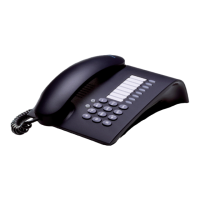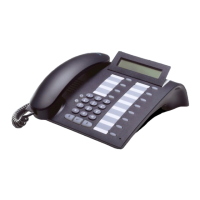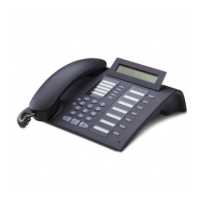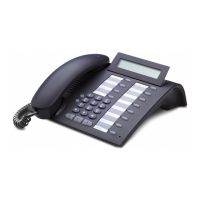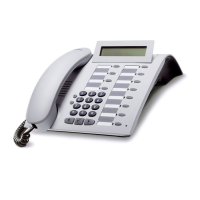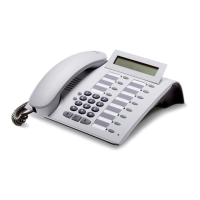


Do you have a question about the Siemens optiPoint 420 standard and is the answer not in the manual?
General warnings and important information for safe operation.
Explains symbols and compliance marks used in the document.
Overview of the telephone control panel and its components.
Guide on how to interpret symbols and follow instructions.
Explanation of how information is presented on the phone display.
Methods to access and activate telephone functions interactively, via menus, or keys.
Overview of available function categories like SLK, basic, enhanced, and team functions.
Tips for optimizing telephone usage and common functions like speed dial and callback.
Procedures for answering incoming calls using handset or speakerphone.
Steps to answer a call using the handset.
Steps to answer a call using the speakerphone.
How to switch from handset to speakerphone during a call.
How to switch from speakerphone back to the handset.
Allows others to listen in on a call via speakerphone.
How to dial a number after lifting the handset.
How to dial a number while the handset is on-hook.
Procedure to end an active call.
How to redial previously dialed numbers.
Accessing and dialing numbers stored for redialing.
Muting the microphone during a call.
How to add a second party to an ongoing call.
How to switch between two parties during a call.
How to transfer an active call to another person.
Setting up call forwarding to other destinations.
Detailed steps for setting up variable call forwarding.
Call forwarding features specific to carrier networks and MSNs.
Setting up call forwarding when the phone is not working.
Feature to automatically call back a busy number.
How to store a callback request.
How to receive and respond to a callback.
Managing stored callback requests.
Storing frequently used numbers on programmable keys.
How to dial numbers saved on programmable keys.
Adjusting various telephone settings like ring volume and tone.
Changing display contrast for better readability.
Changing contrast for key labels.
Optimizing speakerphone performance based on room environment.
Adjusting audio volume during an active call.
Adjusting the display unit's angle for viewing.
Information about automatic display backlight behavior.
Changing the language for on-screen prompts.
Procedures for answering calls, including specific colleague calls.
How to answer a call directed to a colleague.
How to reject an incoming call.
How to use the speakerphone for calls.
How to answer calls using a connected headset.
Interacting with entrance phones and door openers.
How visitors can open the door using a code.
Steps to activate the door opener function.
Steps to deactivate the door opener function.
How to receive calls from an answering machine.
Entering numbers before dialing and correcting them.
Accessing and managing the list of incoming calls.
How to view the list of received calls.
How to exit the caller list view.
Viewing details about calls in the caller list.
Making a call directly from the caller list.
Deleting entries from the caller list.
Saving numbers from the caller list for redialing.
Using speed dial numbers for quick dialing.
How to use pre-stored speed dial numbers.
Programming personal speed dial numbers.
Making calls using the internal phone directory.
Accessing and dialing numbers from an LDAP database.
Accessing voicemail or message systems.
Making announcements to colleagues via speaker.
Automatically connecting to a preset number.
Reserving a busy trunk line for own use.
Assigning specific numbers for outgoing calls.
Using dialing aids for calls.
Handling incoming calls while on an active call.
How to accept a waiting call.
Managing call waiting behavior.
Controlling the audible alert for waiting calls.
Temporarily holding a call to retrieve it later.
How to pick up a parked call.
How to place external calls on hold.
Steps to initiate a conference call.
How the initiator can add more participants.
Viewing current participants in a conference.
How the initiator removes participants.
How a participant can leave a conference.
How the initiator terminates a conference call.
Transferring calls after an announcement to a group.
Sending signals to activate ISDN services via trunks.
Troubleshooting and handling unreachable destinations.
How to join an ongoing call by overriding it.
How to forward calls to a specific station during off-hours.
How to program functions onto telephone keys.
Explains the meaning of LED indicators for programmed functions.
Explains LED status for trunk keys.
Explains LED status for DSS keys.
Lists functions that do not have associated LED indicators.
Saving multi-step procedures to a single key.
Setting up timed reminders or appointments.
How to enter and save appointment reminders.
Managing saved appointment reminders.
How timed reminders are received and acknowledged.
How to view call charge information.
Viewing call charges for other telephones.
Assigning external calls to specific projects using account codes.
Activating/deactivating the ringer to avoid disturbances.
Activating/deactivating the DND feature.
Preventing your number from being displayed to called parties.
Using the phone to listen to a remote room.
Identifying unknown callers.
Securing the telephone against unauthorized access.
Remotely locking other telephones.
Setting up a Personal Identification Number for security.
Sending short text messages to users.
Detailed steps for composing and sending messages.
Managing sent text messages.
How to access and listen to received messages.
Leaving a message for internal callers.
Managing advisory messages.
Showing call queue status and system load.
Using another phone as if it were your own.
Using a remote phone with your settings for extended periods.
Features related to fax and answering machine integration.
Procedure to reset all activated telephone functions.
Remotely activating/deactivating functions on other phones.
Accessing system functions remotely via telephone.
Accessing ISDN functions using codes.
Controlling external systems and data services from the phone.
Switching relays on/off for controlling external devices.
How sensors trigger phone alerts.
Using paging equipment to contact people.
Basic paging procedures.
Advanced paging procedures.
Activating/deactivating group call functionality.
Managing membership in hunt groups or group calls.
Managing membership in complex team structures.
How to answer calls for teammates.
Setting up multiple phones to ring for a call.
How incoming calls are distributed among agents.
Managing agent status for UCD.
Changing agent availability status during work.
Temporarily removing oneself from call distribution.
Managing UCD for night service.
Showing the queue status for UCD.
How trunk keys are used by team members.
Interpreting the status lights on trunk keys.
How to answer calls using trunk keys.
How to make calls using trunk keys.
Managing calls on hold using trunk keys.
How to retrieve a call placed on hold.
Managing multiple calls on different trunks.
Setting up call forwarding for specific lines.
Explains LED status for Forward Line keys.
How DSS keys are used for team communication.
Interpreting the status lights on DSS keys.
How to answer calls using DSS keys.
Making direct calls to team members via DSS keys.
How to transfer a call using DSS keys.
How to answer calls for teammates.
Managing membership in group calls.
Forwarding calls directly to an executive's phone.
Performing a diagnostic test on telephone functions.
Verifying which functions are assigned to specific keys.
How to leave a group call or hunt group in a LAN environment.
Managing call forwarding remotely via LAN.
Setting up night answer remotely via LAN.
Managing ringing groups remotely via LAN.
Remotely controlling relays via LAN.
Remotely activating the door opener via LAN.
Overview of how functions appear on displays in HiPath 4000.
Modifying or reverting key labels.
Method for entering text using the phone keypad.
Information on automatic and manual key labeling.
How to attach call-number labels to the phone.
Information on how to access the manual.
List and description of optional telephone accessories.
Guidelines for cleaning and maintaining the telephone.
Explanation of echo issues and their cause.
Common problems and initial checks.
How to interpret and resolve on-screen error messages.
Who to contact for unresolved issues.
Details on FCC certification and compliance rules.
Information on contacting customer support for service.
Specific FCC regulations regarding digital devices.
Specific FCC regulations regarding telephone connections.
Notices regarding equipment connection and limitations.
Explanation of REN and its impact on telephone line devices.
| Speakerphone | Yes |
|---|---|
| Volume control | Digital |
| Mac compatibility | No |
| Cabling technology | Cat.5 |
| Dimensions (WxDxH) | 225 x 220 x 79 mm |
| Ethernet LAN (RJ-45) ports | 1 |
| Supported network protocols | SNMP, http, DHCP, DNS, FTP |
| Display number of lines | 2 lines |
| Interface | 121 TR9-5/Polaris, 10/100 Base-T Mini-Switch, 10/100 Base-T |
| Product color | Black |
| Weight | 910 g |
|---|



